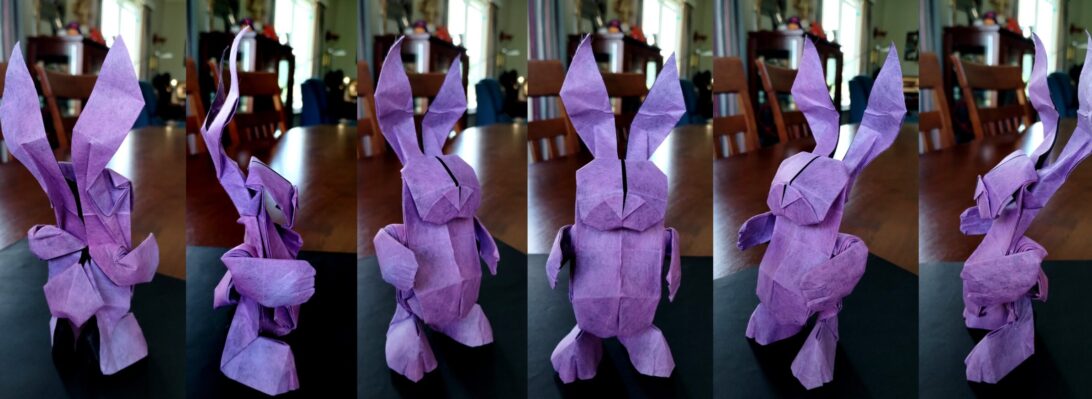For much of the past year (2014) I have been learning how to fold Satoshi Kamiya’s Ryujin 3.5, as taught to me via a series of lessons cunningly devised by Daniel Brown (Mr Origami). I started this project on March 21.
This is Part 3 of a series that also includes Part 1, Part 2
Lesson 18 was folding the head in isolation – I must admit that even when searching for photos on how the head of this beast should end up, none really make it clear. What is clear however is that there is a terrifying amount of detail.
Following photodiagrams (in 3 phases 18a, 18b, 18c), I ended up with a beautiful thing that is my take on how a eastern dragon head should look.
Lovely scaled neck joins (via an astonishingly complex twist and tuck) a complex head with a pair of pronged antlers, 5 pairs of horns on cheeks, a mouth with lovely tongue and 4 sets of teeth, lovely whiskers on the muzzle and lots of little tufts, spikes and textured areas.
This is my first attempt of this step – the paper is REALLY thick so I am amazed it was achieved with no paper fatigue. I wish my photos can capture this model – there is so much happening so it is visually cluttered but wow, just wow.
Looking to do something with this – might try mounting it like a trophy (like a deer or elephant head) … we shall see.
Lesson 19A – Pre-creasing the front half of the dragon, done:
The Collapse (19B) is complicated, tedious but a fascinating piece of paper engineering

Once scales are shaped, we can begin on the hideous (and in some parts completely baffling) collapse of the head
5 weeks in on this section and we are tangibly close to the end.
After some serious wrangling, we are ready to bring head and tail sections together
Using strips of MC’d paper, corresponding pleat troughs are joined to make one continuous model.
Shaping, wiring and closing the body then posing to do
The Morphology of the model is fascinating, I can see how it comes from a single sheet (even though I doubt I will try it)
WIP … the folding continues, carefully.




Wow. You’re a really dedicated origami folder. I’ve tried to make Ryujin over and over for the past few months and have continually failed. Still trying, though 🙂 Good luck with your Ryujin!
Thanks – I am just plodding along, taking my time and trying to understand the fold as much as master it – a model such as this is not to be rushed and is intolerant of sloppy folding I am discovering.
I finally did it!
Good work! It is a journey that us so rewarding, but difficult to see while on it.
Nice work!!! I’m doing the same by myself, can you upload a picture of how do you made the neck twist please?
What happened ? Did you finish the model? Man ! It looks amazing , are u folding without diagram , we pray for some day satoshi can diagram it, without doubt this is the most complex origami model ever seen, please write me !
see here (http://www.wonko.info/365origami/?p=4582) for final fold
Looks pretty great. I’ve been folding my own and just completed my ultimate (hopefully) testfold. However I’ve been stumped as to how the antlers are meant to be formed from the base. Could you explain in any manner how each part of the antler flap are used to make the prongs? Would be very appreciated!
The horns are formed from a pretty routine bit of box pleating (considering the complexity of getting something even remotely head-like to begin with) once the layers for eyes, nose/mouth are sorted
I’ve been trying a variety pleats for a good few weeks now, I just haven’t found one which leaves the model closed at the top with the correct lengths.
The key parts I’m missing are whether the edge of the paper (the thin ridge) is opened up or left alone, whether the thickness of the antler is from the thin ridge or a fraction of the entire flap, and whether the pleating is symmetric or asymmetric.
Again, it would be really great if you could help with any of these. This is the last part of the model that I don’t understand, and is keeping me from the (hopefully) final fold!
Nice Job, Thanks for taking the painstaking time to document the journey along the way.